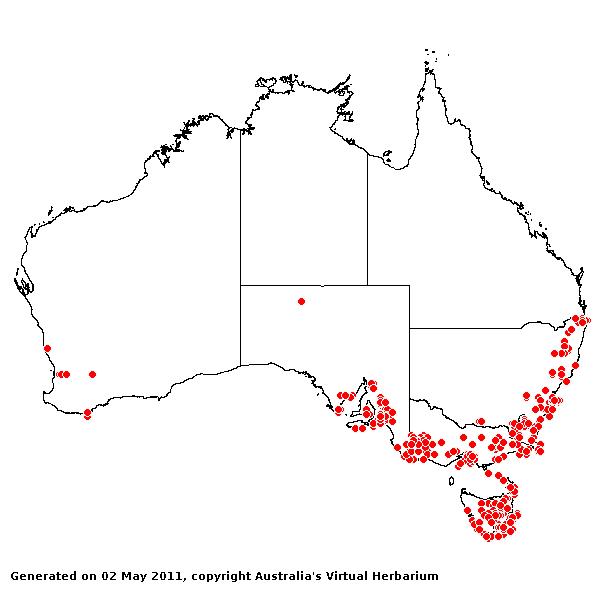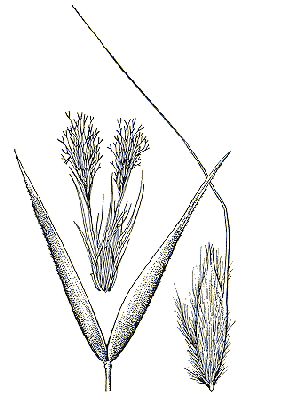Lachnagrostis aemula (R.Br.)Trin. Fund.
Agrost. 128 (1820).
Classification. (GPWG 2001) : Subfamily Pooideae.
Tribe Poeae.
Basionym and/or
Replacement Name: Agrostis aemula
R. Br., Prodr. 172 (1810).
Type of Basionym or
Protologue Information: LT: R. Brown 6219 (pro parte), Australia: New South Wales: Port Jackson and Port
Dalrymple (BM). LT designated by Vickery, Contr. New South Wales Herb 1:
101–119 (1941).
Key references
(books and floras): [1810]. R.Brown, Prodromus (172 as Agrostis
aemula), [1952] C.A.Gardner, Flora of Western Australia 1 Gramineae
(155 as A. aemula), [2002] D.Sharp & B.K.Simon, AusGrass, Grasses
of Australia, [2006] J.Jessop, G.R.M.Dashorst, F.M.James, Grasses of
South Australia (227), [2008] S.W.L.Jacobs, R.D.B.Walley &
D.J.B.Wheeler, Grasses of New South Wales (289), [2009] A.Wilson (ed.). Flora
of Australia,
Vol 44A. Poaceae 2 (176).
Illustrations:
[2006] J.Jessop, G.R.M.Dashorst, F.M.James, Grasses of South Australia (227, fig. 171), [2008] S.W.L.Jacobs,
R.D.B.Whalley & D.J.B.Wheeler, Grasses of New South Wales, 4th edn
(289), [2009]. A.Wilson (ed.), Flora of Australia 44A: Poaceae 2
(182, Fig.26).
Habit. Annual
or perennial. Culms erect, 25–65 cm tall, 2–4 -noded. Mid-culm nodes glabrous.
Leaves mostly basal. Leaf-sheaths scaberulous. Ligule an eciliate membrane, 3–8
mm long, abaxially scaberulous, lacerate, obtuse or acute. Leaf-blades filiform
or linear, flat or involute, 8–20 cm long, 1–5(–7) mm wide. Leaf-blade surface
scaberulous.
Inflorescence.
Inflorescence compound, a panicle. Panicle pyramidal, 9–30 cm long.
Spikelets.
Spikelets pedicelled. Fertile spikelets 1-flowered, comprising 1 fertile
floret(s), with a barren rachilla extension, lanceolate, laterally compressed,
(3.5–)4–7 mm long.
Glumes. Glumes
similar, firmer than fertile lemma. Lower glume lanceolate, membranous, keeled,
1-keeled, 1 -nerved. Upper glume lanceolate, 3–5 mm long, membranous, keeled,
1-keeled, 1 -nerved. Upper glume surface scabrous.
Florets.
Fertile lemma 1.8–4.5 mm long, without keel, 4–5 -nerved. Lemma surface
indumented. Lemma apex dentate, awned, 1 -awned. Median (principal) awn dorsal,
5–10 mm long overall, with a twisted column. Palea apex dentate. Lodicules
present. Anthers 3.
Continental
Distribution: Australasia.
Australian
Distribution: Western Australia, South Australia, Queensland, New South
Wales, Victoria, Tasmania, Lord Howe.
Western Australia: Drummond, Dale,
Menzies. South Australia: Flinders
Ranges, Eyre Peninsula, Northern Lofty, Murray,
Yorke Peninsula, Southern Lofty, Kangaroo
Island, South-eastern. Queensland: Moreton.
New South Wales: North Coast, Central Coast, South Coast, Northern
Tablelands, Central Tablelands, Southern Tablelands, North-Western Slopes,
South-Western Plains. Victoria: East Gippsland, Eastern Highlands,
Gippsland Plain, Grampians, Lowan Mallee, Midlands, Murray Mallee, Wilsons
Promontory, Riverina, Volcanic Plain, Wannon, Wimmera. Tasmania:
Furneaux Group, North West, North East, West Coast, Central Highlands,
Midlands, Ben Lomond, East Coast, South West, Mt Field, Mt Wellington.
Notes.
Endemic. Flowers spring-summer.
Occurs
in all states and territories except the N.T., also on Lord Howe Is. Coastal,
in grasslands or under light woodland, more common in lowland areas but
extending to subalpine regions in Tas. and Vic. Flowers Sept.-Jan.



